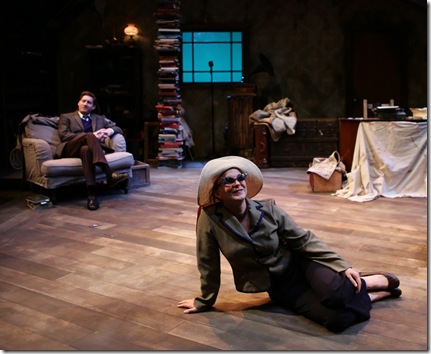Dear Elizabeth, a moving tale of the relationship between poets Elizabeth Bishop and Robert Lowell on the Lyric stage of Boston.
Ed Hoopman and Laura Latreille. Photo: Mark S. Howard
Sarah Ruhl’s haunting epistolary play Dear Elizabeth, now at Boston’s Lyric Stage, is drawn from poets Elizabeth Bishop and Robert Lowell’s thirty year correspondence, ended by Lowell’s death. The relationship began in 1947 at a party when they met at an important point in each of their lives. At age thirty, Lowell had won the Pulitzer Prize and the thirty-six year old Bishop’s first book of poems had just been published. They instantly took to one another as fellow poets, although Lowell’s attraction to Bishop was also sexual. A lesbian, Bishop loved him as an irreplaceable friend. Fittingly, the written word was their means of communication. They seldom saw each other; Bishop lived in Brazil with her lover Lota while Lowell resided mostly in the US.
Unlike other epistolary plays such as A. R. Gurney’s Love Letters in which the actors stand and read, playwright Ruhl envisioned them in a room speaking their letters to one another as in conversation. Shelley Barish designed a ghostly garret for the Lyric’s production, filled with cartons, shabby furniture, including a desk upstage center, and multiple props, amongst them an ancient windup Victrola. Dominating the room is a narrow, ceiling high, jam-packed bookcase. While we sometimes see Lowell sitting on a chair writing in the space, the room gives the impression of being Bishop’s study. In contrast with Lowell, she seldom leaves the stage.
At the opening, all is still and shrouded until a bent, aged Elizabeth Bishop (Laura Latreille) enters, removes the desk cover, revealing a decrepit typewriter and sits, now a young woman typing her first letter to Lowell. In response, Robert Lowell (Ed Hoopman) appears downstage, speaking his letter to her. Often, the letters are spoken at a distance from the recipient, at times with the reader’s back to the other. When the two come together, usually the correspondence is about a shared experience as, for example, when years later, the two sit together on a Maine beach, represented by a small trap filled with water they playfully splash at each other.
Their relationship deepens; their elegant letters become more confiding, but never lose a certain old-fashioned reticence – lost in today’s tell-all world – which Lowell hides behind dry humor. He battles with serial marriages and manic depression, she with alcoholism and the death of her lover Lota. Their most profound intimacy lies in the sharing of their work. While admiring of each other’s poems, they, particularly Bishop, could in the spirit of help be critical..
Laura Latreille and Ed Hoopman turn in sensitive, well-crafted performances. Latreille’s makeup and severe hair style bring out a resemblance to Bishop. During most of the show, her speech is high-pitched, girlish, and lacks variety, which seems a deliberate choice, given that Bishop disliked the sound of her own voice. She seldom allowed anyone to record her. As Bishop ages and becomes more confident, Latreille’s voice deepens, grows subtler, and more expressive.
Hoopman does not attempt to reproduce Lowell’s readings despite the many recordings available. He relies on his mellow voice to give his own interpretation.
A. Nora Long’s direction illuminates the text and characters. The pacing is on target as is the blocking. Dear Elizabeth offers audiences an unusual and pleasing theatre experience.
The Lyric Stage of Boston, Spiro Veloudos, Artistic Director
Written by Sarah Ruhl
Directed by A. Nora Long
Scenic Design, Shelley Barish
Costume Design, Emily Woods Hogue
Lighting Design, Karen Perlow
Sound Design, Andrew Duncan Will
Featuring Ed Hoopman and Laura Latreille
